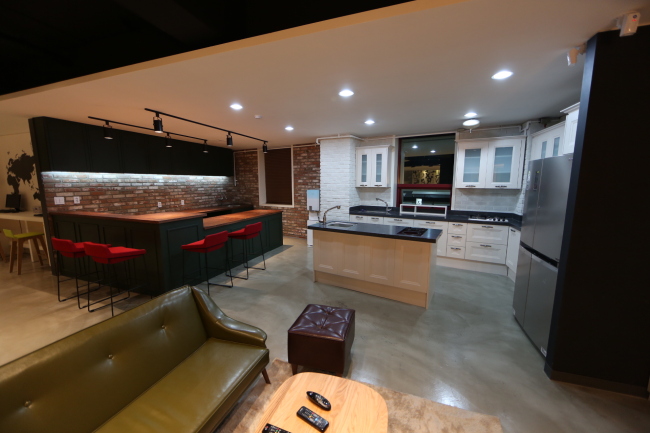[Weekender] ‘Vloggers’ at forefront of one-man media
By Korea HeraldPublished : May 29, 2015 - 19:17
Today, in a world where anyone can easily upload a video of themselves doing anything and everything, video blogging has become the new mode of self-expression.
“Vloggers” ― or video bloggers, who film or live-stream their thoughts, ideas and interests, have become tremendously popular here in the past years. Some of them rack up fans just like K-pop celebrities, while others are earning significant income through broadcasting online.
The genres vary, befitting the increasing influence of video content. From online game broadcasting and beauty tutorials to devouring massive amounts of food, better known here as meokbang (eating broadcast), a diverse array content quenches the entertainment thirst of users in Korea, one of the most wired countries in the world.
“Vloggers” ― or video bloggers, who film or live-stream their thoughts, ideas and interests, have become tremendously popular here in the past years. Some of them rack up fans just like K-pop celebrities, while others are earning significant income through broadcasting online.
The genres vary, befitting the increasing influence of video content. From online game broadcasting and beauty tutorials to devouring massive amounts of food, better known here as meokbang (eating broadcast), a diverse array content quenches the entertainment thirst of users in Korea, one of the most wired countries in the world.

With the rise of pioneering vloggers, a new breed of business has emerged in this fast-paced, smartphone-savvy society.
Multichannel network businesses ― which aggregate multiple content creators under one banner and assist creators in producing, marketing, funding and copyright issues ― is the rising tide of business, like elsewhere in the world.
The MCN takes the managerial role, providing vloggers the expertise in content creation and distribution, in exchange for a percentage of their advertisement revenue. This business model was made possible in 2012 when YouTube ― the largest video platform ― lowered its restrictions on its Partner Program, allowing all creators to generate advertisement revenue from their videos; they only need to apply for it.
CJ E&M, the nation’s leading entertainment and media company, was the first to jump onto the MCN bandwagon here in 2013. The conglomerate recently rebranded its 2-year-old MCN business into DIA TV, an acronym for Digital Influence & Artist TV, in an effort to bring a slew of domestic vloggers to wider global audiences.

“This business started with a perspective that content had to become a brand itself,” said Lee Deok-jae, head of the company’s broadcasting and contents business, at the recent launch of the service. “If we can’t earn profit beyond the domestic market, the business cannot last long and will face limitations.”
“There are many creators with great talents who cannot advance overseas due to language barriers and other aspects,” he said. “We will provide solutions to the problems.”
DIA TV gives practical help to its partners, including their newly opened DIA TV Studio in Hongdae, western Seoul. The space is provided exclusively for the creators to film, edit and produce their content. The fully equipped studio even has a kitchen for those shooting cooking programs and a rest area where partners can hangout and network with other creators.
As of today, DIA TV partners with 407 content creators on YouTube, including famous vloggers such as Korean Englishman. With over 700,000 subscribers, the British-native talks about unique Korean culture through the eyes of a non-Korean.
The company’s goal is set to increase the number of content creators to 2,000 by 2017.
Another strong player in the video platform industry is AfreecaTV, short for Any Free Casting TV.
Established in 2006, the video-streaming platform gained ground here for its unique service in which users ― called broadcast jockeys, or BJs ― can host live shows and chat real-time with viewers. If the viewers like the show, they can send virtual currency “star balloons” to BJs, which can be cashed out later.
Recently, AfreecaTV has headlined news outlets across the world for its phenomenal meokbang, where BJs devour at least five to 10 servings of food in one sitting, all the while chatting with their loyal fans.
The perk of streaming through AfreecaTV is that BJs can create content on their own and broadcast and communicate with viewers directly, said Lee Young-min, PR representative of the company.
“When it comes to self-broadcasting, it’s the battle of content,” Lee said. “The key to success is creating content creatively and persistently. And that’s not something the individual can always figure out on their own, so we are trying to help the BJs to create good content.”
AfreecaTV selects 40 popular BJs out of thousands of users and grants them the title of Partner BJ, which comes with financial benefits such as no advertisement commission to the company. This coveted group of creators can generate profits in two ways. They collect star balloons during the live broadcast and after the show, they can upload their video to YouTube and earn advertisement profits, with no commission to AfreecaTV.
Another player is Pandora TV, the oldest and the largest video-sharing website here. The company assists content creators through its upgraded iApp service.
It allows vloggers to create their own mobile application composed of their own videos to effectively promote their channels. The service also launched a video-editing program to assist content creators in easily creating videos.
“For the self-video creators who find video production difficult, iApp will provide an opportunity to create their own application and earn profits,” said Lee Jang-won, marketing head of the company at the launching event in February.
While the introduction of MCN has brought independent vloggers inside the chain of the larger media ecosystem, granting them a voice almost equivalent to traditional media, experts point out that the gatekeeping role is missing in the vlogger industry.
Content on social media is circulated based on personal taste and trending headlines, as opposed to traditional media where content is delivered in the order of perceived importance.
“That is the criticism of social media,” film director Choi Gong-jae, who is mindful of this issue, told the Korea Herald
Choi stressed that MCN businesses had a role to play in this changing media environment.
“They need to work with vloggers to create an ecosystem to nurture creativity, while disseminating good content for the long-running industry,” Choi said. “Companies need to think of the MCN industry as an investment, look beyond short-term profit and focus on unearthing underrated vloggers with potential.”
By Ahn Sung-mi and Lim Jeong-yeo
(sahn@heraldcorp.com)(kaylalim@heraldcorp.com">sahn@heraldcorp.com)(kaylalim@heraldcorp.com)
-
Articles by Korea Herald





![[Music in drama] Rekindle a love that slipped through your fingers](http://res.heraldm.com/phpwas/restmb_idxmake.php?idx=644&simg=/content/image/2024/05/01/20240501050484_0.jpg&u=20240501151646)




![[New faces of Assembly] Architect behind ‘audacious initiative’ believes in denuclearized North Korea](http://res.heraldm.com/phpwas/restmb_idxmake.php?idx=644&simg=/content/image/2024/05/01/20240501050627_0.jpg&u=20240502093000)








![[Today’s K-pop] Stray Kids go gold in US with ‘Maniac’](http://res.heraldm.com/phpwas/restmb_idxmake.php?idx=642&simg=/content/image/2024/05/02/20240502050771_0.jpg&u=)